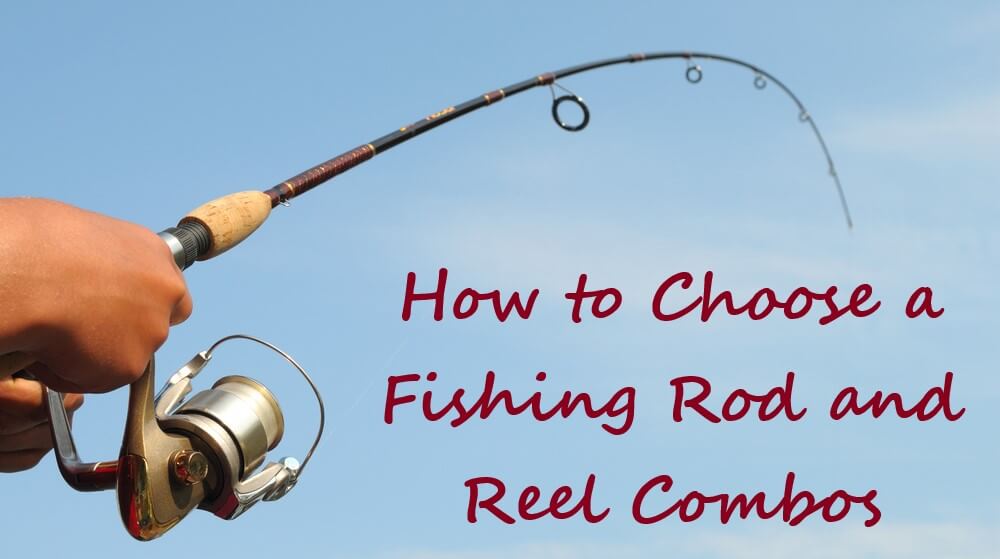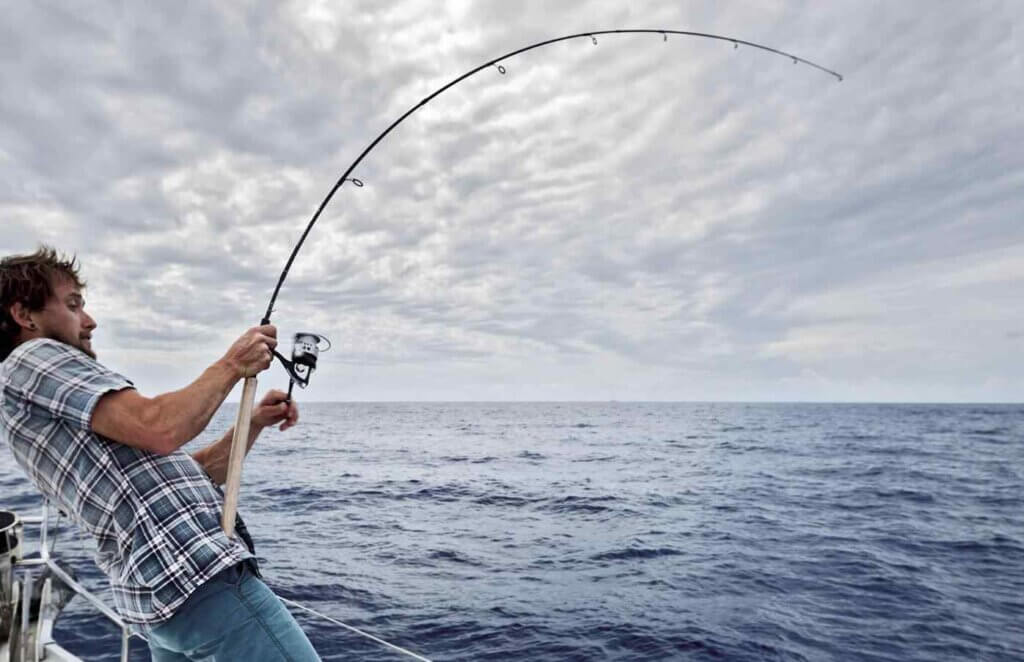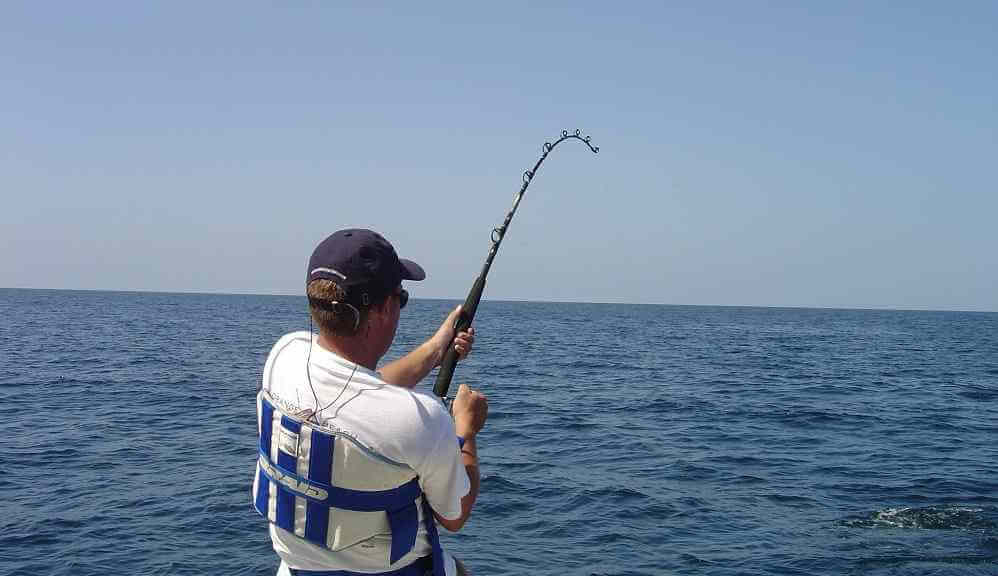
A good fishing rod and reel will contribute majorly to the productivity of your fishing trip.
It becomes very overwhelming if you do not know how to choose a fishing rod and reel. This is an issue faced by people who are first-timers and amateurs.
Even with so many options available in the market, the right guidance can help you make the right decision. Despite being a professional angler, you may require some help to choose your fishing rod.
The guide contains a detailed insight into the different important elements to be considered while choosing a fishing rod and reel.
Mechanism of the Rod and Reel
The release mechanism that a fishing rod and reel use can either be a manual or an automatic tool for casting control. It is mounted at a position ahead of the handle position of any fishing rod.
When one rotates the handle on the fishing rod, which is present over the fishing reel’s side, the spool also rotates.
This helps to retrieve the line at a ratio of 1:1. This means that one whole revolution of the fishing handle is equivalent to one complete spool process.
A fly reel, which is a kind of fishing reel, is straightforward. This reel has very few parts when it is compared to a spinning kind of reel.
There is something known as the drag system, which helps add or else remove tension to the fishing line you are using.
It can be a long process to learn how to choose a fishing rod for beginners as it is not a single one-line answer. It will take you some time and guidance to understand the mechanism of a fishing rod and reel.
Let’s dive more into this combination of the rod and reel!
Our Buying Guides:
- 7 Best Baitcaster Combos for Beginners [Buyer’s Guide]
- Top 10 Best Deep Sea Fishing Rod and Reel Combo in 2021
- Best Fishing Rod and Reel Combo for the Money in 2021
Rod and Reel Combination for Beginners

When wondering how to choose a fishing rod for beginners, the rods’ specifications must be considered. The specifications for the reel, though, are equally as important.
The correct reel and rod combination will make your fishing expeditions fun and adventurous. With an incorrect pairing, you might end up not catching any fish at all or end up with dysfunctional fishing gear.
The fishing reels also come in variations of types and uses and different sizes as well. A 25-30 or 25,000 and 30,000 sized reel can go well with a medium or medium-heavy spinning rod.
The species you wish to go for also determines your reel and rod type and combination. The smoothness of the drag and the resistance also are important factors to consider when matching reels.
You can often get a reel and rod as a combined set; some prefer to combine their own picks of reels and rods.
Whatever you go with, it is important to note that the rods will come with a few specifications.
The model number, size, line weight, etc., will be written on the rod and the reel type parameters.
It is usually better to stick within the reel and rod combination parameters, but there’s no harm if you want to customize.
Just make sure that your rod has the bend you prefer, and your reel has enough stability to not spin out of control.
The reels popularly preferred come in 2 types- casting reel and spinning reel.
Spinning Reel
Spinning reels, like spinning rods, are a pretty popular choice for beginner fishers. They have more accuracy than spin-cast and baitcasting reels and are also easier to use.
They don’t have the casting reels’ complexity and are a good fit for people starting urban fishing.
The reels sit beneath the rod and not on the top like in the casting rods and reel combinations. With an open-faced design, the spool of the spinning reel will rotate as you turn the handle.
It is important to note that spinning reels generally do well with twenty-pound line weight, and though you could go more decadent, it is safer to stick to the model limits.
When selecting your combination of spinning reels, consider the frame, gear ratios, spool diameter, smoothness, anti-reverse, and drag system along with your budget.
Baitcasting Reel
When looking to match your rod with a suitable reel, you must check out the gear ratio before doing so.
The gear ratio typically includes the categories of low, medium, and high. They determine the performance of your reel and also its compatibility with the rod.
The reel sits on top of the rod in bait casting or spin casting reels, unlike the spinning reels positioned underneath.
Casting reels like baitcasting reels are mostly designed with a complexity that matches the needs of a professional.
They’re made for long-distance casting and more extensive and heavier lures. Many come with anti-reverse drags and handles to slow down the runs of large game fish.
Heavier lures are preferred for baitcasting reels as the spool is rotated, and the lure is propelled further by the forward cast’s momentum.
When Matching the Reel with the Rod
When it’s time to choose the combination fit for your rod and reel, it is better to go with the specifications listed.
They will give you an idea of the models, weight, and size you can match with your rod so that your gear is perfectly compatible.
You will usually find numbers like 130/10, 260/6, 190/8, displaying the strength and length. The first set of numbers is for the length, while the number is the line’s strength for that particular line length.
If you have chosen an affordable rod, then don’t pair it with an expensive reel and vice versa. It is better to keep them both in the same range of budget.
If your rod is lightweight, then stay away from heavy side reels, and if it’s heavier, then don’t settle for a light reel.
Matching the weight specs will give you a smoother fishing time.
A big reel is for a big rod, and a smaller reel is for a shorter rod. Even when you choose a budget-friendly option, look for reel combinations that don’t include too much plastic.
Aluminum, metal, and other materials are better than plastic and give your reel durability and strength.
Spinning reels are preferred for beginners for many reasons. Although they’re more comfortable than casting reels, they tend to have simpler mechanisms.
They are also much more affordable and can easily be switched between left and right hands, which gets complicated with casting reels.
They do have a shorter casting line, though, and are less powerful than casting reels.
Type of Reel to Be Used in a Fishing Rod

The kind of reel that you will be using is an essential component. You cannot just choose any reel that you see.
Whether you are a new angler or a professional one, you need to be very cautious when choosing your reel.
What reel suits someone else may not be the perfect reel for you. That is why you need to know about the two major reels that are available.
Reels
Spinning reels are great for amateur anglers and are created for small lures and baits.
Most spinning reels are equipped with an anti-reverse mechanism that stops the spool once the bite has been caught. They are also very easy to use.
With the skirted spools, the reel’s inner working is protected from getting damaged when used in saltwater. This rod can be also be used by left-handed people with a handle placed underneath.
Casting Reel
Casting reels have line feed that is mounted parallel to your fishing rod. There is a button present on your thumb position when gripping the rod’s handle.
This button is used for launching the cast, giving the angler complete control. You can stop or start the cast using this button, which is a convenient feature.
Reel Seat Material
The area where the reel is placed on your fishing rod is known as the reel seat. There are collars present on the rod where the foot or anchor point will be slid into and then tightened.
The material of the reel seat is another essential component to be considered.
Most professional anglers choose graphite seats since they are sturdier. There are also specific rods with inferior material used for the seats.
These reel seats do not have the necessary cushioning material inside the collar.
The reel seat material should have proper cushioning and also able to grip the reel properly.
Moreover, the reel should be tightened well enough so that it does not come loose while casting.
Guides of the Fishing Rod
On the shaft’s length, you will find tiny eyelets that are known as guides. Through these guides, you will have to thread the fishing line, which gives control to the angler.
Most of the fishing rods these days have a metal frame guide combines with circular center ceramic.
Some anglers look for silicon carbide guides due to their smooth texture, which is advantageous while casting.
The increasing number of guides in a rod will ensure that the vesting is better since the power will be transferred equally.
You need to look for a guide material that will reduce the line’s friction, thereby making it last longer.
Ferrules Present In a Fishing Rod
Ferrules are present in fishing rods that are collapsible and need to be connected. There are two ferrules in a rod – one female and one male. It would help if you connected the male and female ferrules to connect the rods securely.
When you connect the ferrules, you should always check that the guides are in the correct alignment. If this does not occur, you will face issues while threading the fishing line.
Ferrules should be tightened properly so that the rod does not collapse mid-way when casting. Also, make sure that the lure you are putting is proportional to the weight these rods could handle.
Different Types of Rods
Two of the most common type of rods is the spinning rod and the casting rod. However, in current times there are many other rods that anglers can use. Let’s take a look at the different rods that you can choose from.
Spinning Rods
The spinning rod has been around for years and is a prevalent one that anglers choose.
This rod is available in different price ranges, lengths and can be used for several applications. The average length of this rod is somewhere around six to seven feet.
You will not have a problem finding a spinning rod for yourself, starting from cheap versions to high-end ones.
For amateurs, it is better to choose a spinning rod that does not bend or fluctuate. It should remain straight when you hold it horizontally.
Spin Casting Rods
The spin casting rod is generally shorter than most types of rods. They are lightweight with small guides.
These rods are mainly manufactured for novice anglers and children. For professional anglers, this rod is said to be of very low-quality.
If you are an expert angler, then it is better to avoid this rod. However, if you are an adult but have just started your fishing journey, you can go for the rod. This will help you learn the basics of fishing until you shift to a better rod.

How to Set Up the Reel and Rod
It can seem not very easy to fix the reel and the rod together. Some rods have reels positioned on the top, while others have it on the underside and beneath the actual rod.
The position of the reel will be dependent on the type of rod you choose. The spinning ods host the spinning reels underneath the rod while the casting rod types position the reels on top of the rod.
Here are the steps to set up your rod and reel together.
For Spinning Rod and Spinning Reel
Step 1: Get all your equipment in one place. When you have it all gathered together, it will be easier to see what goes where.
You will also need to have your fishing line, bait or hook along with the rod and reels. Also, keep a pair of scissors around in case you need them.
Step 2: You will then need to connect the reel and the rod. To do that, first, adjust the reel seat and loosen it if required. The reel foot should properly fit in the reel seat.
Step 3: Place the reel foot in the reel seat and fit it correctly and tightly. The reel should not wobble and should be stable and sturdy.
Step 4: Put the line on, or spool the reel. It would help if you made sure the bail is open and then put the line around the reel once. This will split the line into two attached pieces that will connect around the reel.
Step 5: Using those two pieces, tie an overhand knot. You will get a bit of line again and tie it off with another knot.
Step 6: With a distance of about one-fourth of an inch away from the reel, cut the loose piece of the line out.
Step 7: You will need to close the bail and hold the line tightly around a foot away from the reel to prevent the line’s tangling.
Step 8: To reach the preferred amount of line reel, turn the reel till you get it. This will depend on your kind of reel and line you’re using.
Step 9: You need to string the rod using the line’s tip and place the red line through the rod guides.
Step 10: Make a fishing knot. Then move on to the set up for the drag. Make sure the drag knob is tight; if not, move it clockwise to make it tighter. From your reel, pull the line to set the drag at a preferred amount.
Now you should be set to cast your bait and catch yourself some amazing game fish.
Wrap Up
The article is a great way to help you understand how to choose a fishing rod and reel combo for your next fishing trip.
Having proper knowledge is essential before you venture into a new field. This guide could prove to be an excellent assistance for people who are experts in this field.
Choosing the perfect reel and rod is the first step to having the best fishing experience.
Overall, you need to focus on the type and quality of the reel and rod you opt for. Many other considerations have been explained in detail in the guide.
Make sure that you opt for a well-known brand when you choose your fishing rod and reel.
